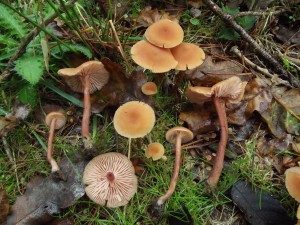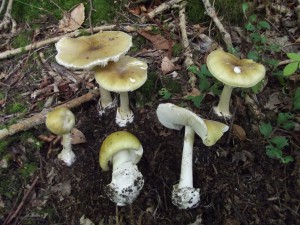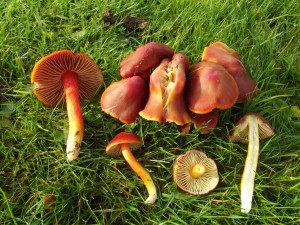Email: geoffdann@hotmail.com
Phone: 07964 569715
30/01/2015
I am pleased to be able to announce that I am now working on a book that will set a new standard for British fungi foraging guides. It is due to be published next September, and will provide information on over 350 fungi recorded as present in the British Isles and the temperate and montane areas of Europe. Detailed information and high quality photographs will be provided on over 300 of the most important edible, toxic and very common species, plus a few that are of interest for other reasons.
The book will be published by Green Books.
The pictures shown here are examples of the quality of the photography to expect from this book. An extract of the text follows.
British fungi foraging: from mycophobia to mycomania
Not so long ago the only wild fungus that the British even thought about picking was the humble field mushroom, and most people were so scared of eating something dangerous that they wouldn’t even touch those. It wasn’t always like that. I have a book published in 1941 – “Wild Foods Of Britain” by Jason Hill – that features another five. But even if we reached a particularly low ebb in the late 20th century, the people of these islands have always been rather mycophobic compared to the majority of other European nations. We can only guess at the reasons for this. One theory is that the druids were the only class of people allowed knowledge of fungi in ancient Britain, and everybody else was taught to fear them. It is certainly the case that we’ve historically associated “toadstools” with witches, bats, spiders and…toads. The word “toadstool” has no meaning beyond “like a mushroom, but you wouldn’t want to eat it” and is liable to be applied to any sort of mushroom that isn’t an Agaricus (the genus to which the field mushroom and cultivated mushroom belong). Whatever the reason for this historical mycophobia, we are currently in the midst of a dramatic cultural change of heart. Foraging, especially foraging for fungi, has never been more popular in Britain, and interest is rapidly growing.

The Deceiver: surprising edible, but surprisingly good at fooling you it is actually something else.
Why has this happened? Why now? There are two main reasons. The first is a widespread food revolution: no longer is Britain the land of fried breakfasts, fish and chips, roast beef and not much else. We now have a massive diversity of restaurants, serving food from all around the world. Pubs have become gastro-pubs. Cookery competitions dominate prime-time television. No surprise then that the foodies among us are taking a greater interest in the possibility of finding, fresh and for free, delicacies that cost a small fortune and are often only available dried – if you can buy them at all. The other strand is a broad cultural trend towards sustainability, self-sufficiency and a desire to reconnect with the landscape and the natural world. There is a sense that our civilisation is an out-of-control monster, heading towards catastrophe, both economic and ecological. And we’ve responded with a desire to re-learn ancient and forgotten skills, from growing our own food, to making essential items using pre-industrial technologies, knitting and mending old clothes, right back to knowing how to track animals and start fires without matches. Foraging for wild food fits very well into this cultural backdrop.
There’s still a lingering fear of eating the wrong fungus and ending up in hospital – or worse. This isn’t entirely a bad thing. In some European nations where gathering fungi has always been a national pastime, cases of poisoning caused by wild fungi are counted in their tens of thousands annually. Fear, leading to caution, can sometimes be a life-saver. Foraging for fungi can be done safely though. One just has to exercise a certain amount of common sense, and follow a few rules.
There’s another advantage to our mycophobic history: we come at this with no pre-existing ideas of what is edible and what isn’t. Most of my foraging students start off knowing absolutely nothing about fungi. Contrast that with the Russian family who hired me because they wanted to introduce their five-year old daughter to foraging. All they actually wanted from me was to show them somewhere they could find some of the things they knew from back home. When I tried to teach them about other edible species – good ones – they said, “We don’t eat those in Russia.” “But you hired me to teach you about edible fungi, and I’m telling you those are good to eat!”, I said, but they were having none of it. Each country has its own idiosyncrasies – its own selection of things traditionally eaten and things traditionally rejected. Lacking any tradition (apart from rejecting almost everything), we in Britain have the chance to approach this topic with an open mind, and that can only be a good thing.


